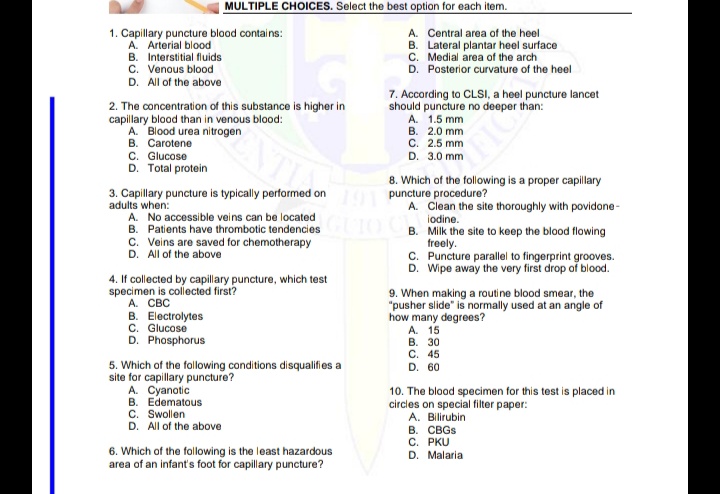1. Capillary puncture blood contains: A. Arterial blood B. Interstitial fluids C. Venous blood D. All of the above 2. The concentration of this substance is higher in capillary blood than in venous blood: A. Blood urea nitrogen B. Carotene C. Glucose D. Total protein 3. Capillary puncture is typically performed on adults when: A. No accessible veins can be located B. Patients have thrombotic tendencies C. Veins are saved for chemotherapy D. All of the above
1. Capillary puncture blood contains: A. Arterial blood B. Interstitial fluids C. Venous blood D. All of the above 2. The concentration of this substance is higher in capillary blood than in venous blood: A. Blood urea nitrogen B. Carotene C. Glucose D. Total protein 3. Capillary puncture is typically performed on adults when: A. No accessible veins can be located B. Patients have thrombotic tendencies C. Veins are saved for chemotherapy D. All of the above
Chapter11: Administration Of Nonparenteral Medications
Section: Chapter Questions
Problem 21RQ
Related questions
Question

Transcribed Image Text:MULTIPLE CHOICES. Select the best option for each item.
1. Capillary puncture blood contains:
A. Arterial blood
B. Interstitial fluids
C. Venous blood
D. All of the above
A. Central area of the heel
B. Lateral plantar heel surface
C. Medial area of the arch
D. Posterior curvature of the heel
7. According to CLSI, a heel puncture lancet
should puncture no deeper than:
A. 1.5 mm
B. 2.0 mm
C. 2.5 mm
D. 3.0 mm
2. The concentration of this substance is higher in
capillary blood than in venous blood:
A. Blood urea nitrogen
B. Carotene
C. Glucose
D. Total protein
3. Capillary puncture is typically performed on
adults when:
A. No accessible veins can be located
B. Patients have thrombotic tendencies
8. Which of the following is a proper capillary
puncture procedure?
A. Clean the site thoroughly with povidone-
iodine.
B. Milk the site to keep the blood flowing
freely.
C. Veins are saved for chemotherapy
D. All of the above
C. Puncture parallel to fingerprint grooves.
D. Wipe away the very first drop of blood.
4. If collected by capillary puncture, which test
specimen is collected first?
9. When making a routine blood smear, the
"pusher slide" is normally used at an angle of
how many degrees?
A. 15
В. 30
C. 45
D. 60
А. СВС
B. Electrolytes
C. Glucose
D. Phosphorus
5. Which of the following conditions disqualifies a
site for capillary puncture?
A. Cyanotic
B. Edematous
C. Swollen
D. All of the above
10. The blood specimen for this test is placed in
circles on special filter paper:
A. Bilirubin
В. СBGS
C. PKU
D. Malaria
6. Which of the following is the least hazardous
area of an infant's foot for capillary puncture?
Expert Solution
This question has been solved!
Explore an expertly crafted, step-by-step solution for a thorough understanding of key concepts.
This is a popular solution!
Trending now
This is a popular solution!
Step by step
Solved in 4 steps

Recommended textbooks for you



Essentials Health Info Management Principles/Prac…
Health & Nutrition
ISBN:
9780357191651
Author:
Bowie
Publisher:
Cengage



Essentials Health Info Management Principles/Prac…
Health & Nutrition
ISBN:
9780357191651
Author:
Bowie
Publisher:
Cengage



Basic Clinical Lab Competencies for Respiratory C…
Nursing
ISBN:
9781285244662
Author:
White
Publisher:
Cengage